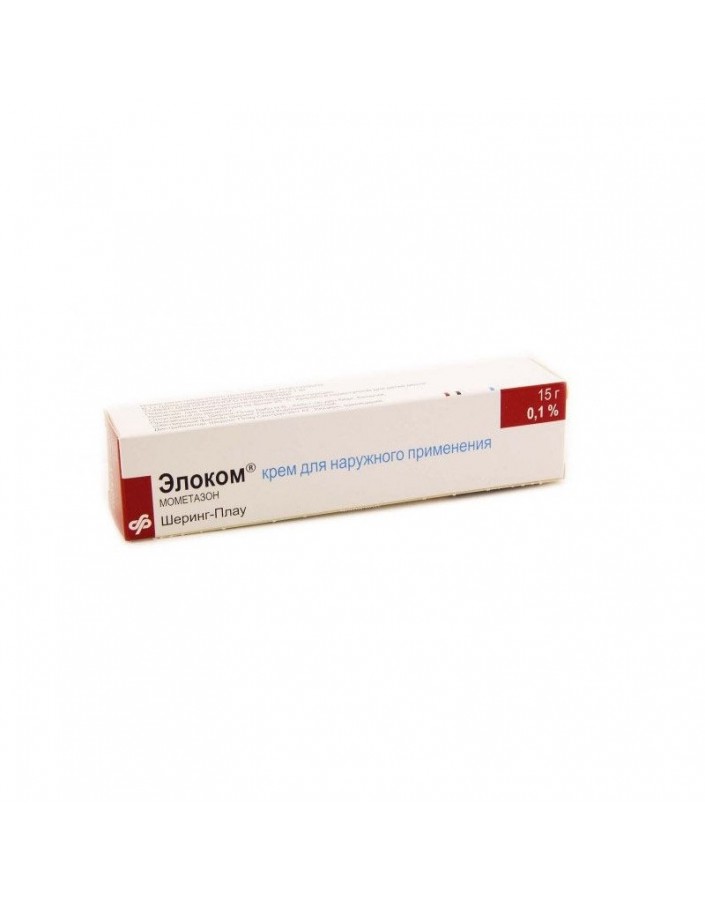




Security policy (edit with Customer reassurance module)

Delivery policy (edit with Customer reassurance module)

Return policy (edit with Customer reassurance module)
Cream
1 gram of cream for external use of 0.1% contains: mometasone furoate 1 mg.
Excipients: hexylene glycol, phosphoric acid, propylene glycol stearate, stearyl alcohol, cetyl stearyl ether, ceteareth-20, titanium dioxide, aluminum octenylsuccinate (obtained from starch), white wax, white petrolatum, purified water.
In a tube of 15 grams of cream. In the package 1 tube.
Cream Elocom - GCS for external use.
It has anti-inflammatory, antipruritic and antiexudative action. GCS induce the secretion of phospholipase A2 inhibiting proteins and commonly known as lipocortins, which control the biosynthesis of inflammatory mediators such as prostaglandins and leukotrienes by inhibiting the release of their common precursor, arachidonic acid.
Inflammatory reactions and itching in dermatoses, susceptible to treatment of corticosteroids.
- Pink acne, perioral dermatitis.
- Bacterial, viral (Herpes simplex, Herpes zoster, chicken pox), a fungal infection of the skin.
- Tuberculosis.
- Syphilis.
- Vaccination reactions.
- Children's age up to 2 years.
- Pregnancy (use on large areas of the skin, long-term treatment).
- Lactation period (use in large doses and / or for a long time).
- Hypersensitivity to the drug or GCS components.
Caution should be:
- Apply the drug on the skin of the face and intertriginous skin.
- Use occlusive dressings.
- Apply on large areas of skin and / or for a long time (especially in children).
The safety of mometasone furoate during pregnancy and lactation has not been studied. GCS penetrate the placental barrier. Long-term treatment and use in high doses during pregnancy should be avoided due to the risk of adverse effects on the development of the fetus. GCS is excreted in breast milk. If you need to use GCS in high doses and / or for a long time, you should stop breastfeeding.
The cream is applied with a thin layer to the affected skin 1 time / day. The duration of the course of treatment is determined by its effectiveness, as well as by the tolerance of the patient, the presence and severity of side effects.
When using external forms of GCS for a long time and / or for the treatment of large areas of the skin, or using occlusive dressings, especially in children and adolescents, side effects can occur that are characteristic of GCS systemic effects, including adrenal insufficiency and Cushing syndrome.
Local reactions: rarely - irritation and dryness of the skin, burning sensation, itching, folliculitis,hypertrichosis, acne, hypopigmentation, perioral dermatitis, allergic contact dermatitis, the addition of a secondary infection, skin maceration, signs of skin atrophy, stretch marks, prickly pears; less than 1% - the formation of papules, pustules.
When used on large areas of the skin for a long time, especially when using occlusive dressings, GCS may enter the systemic circulation and develop the systemic action of the GCS. Given this, patients should be observed in relation to signs of suppression of the function of the hypothalamic-pituitary-adrenal system and the development of Cushing's syndrome.
Avoid contact with eyes. Propylene glycol, which is part of the drug, can cause irritation at the site of application, and isopropanol - a burning sensation when it comes into contact with inflamed skin. In such cases, you should stop using Elokoma and prescribe the appropriate treatment. It should be borne in mind that GCS can alter the manifestations of certain skin diseases, which may make diagnosis difficult. In addition, the use of corticosteroids may cause delayed wound healing. With long-term GCS therapy, the sudden cessation of therapy can lead to the development of rebound syndrome, manifested in the form of dermatitis with intense reddening of the skin and a burning sensation. Therefore, after a long course of treatment, the abolition of the drug should be made gradually, for example, switching to an intermittent treatment before it is completely stopped.
Use in pediatrics: Due to the fact that in children the ratio of surface area and body weight is greater than in adults, children are at greater risk of suppressing the function of the hypothalamic-pituitary-adrenal system and the development of Cushing's syndrome when using any GCS local action. Prolonged use of GCS in children can lead to impaired growth and development. Children should receive a minimum dose of the drug, sufficient to achieve the effect.
Symptoms: depression of the hypothalamic-pituitary-adrenal system, including secondary adrenal insufficiency.
Treatment: symptomatic, if necessary - correction of electrolyte imbalance, drug withdrawal (with long-term therapy - gradual withdrawal).
The drug should be stored at a temperature of from 2 to 25 ° C.
2 years.
Elocom 01%